Matthew Rodriguez visits South Flores st. in San Antonio
Posted by justin on January 11, 2:33 pm | Category: acquisitions, adventure day, art paparazzi, graffiti
Posted by justin on January 11, 2:33 pm | Category: acquisitions, adventure day, art paparazzi, graffiti
Posted by justin on January 10, 3:08 pm | Category: adventure day, ice, party photos, silliness
Posted by hillssnyder on January 9, 10:16 am | Category: uncategorized
The grandeur of your epaulet is inspirin’, Colonel. Please inform the Quartermaster that Miss Lillywhite has got her underpants in the mud. However, she does not require assistance as she has come prepared with a pair of zircon encrusted tweezers. Her golden brow is festooned about with thoughts becomin’ such a child. Later she will join us on the veranda.
Posted by thomas-cummins on January 9, 1:23 am | Category: cellphonevideo, photography
Here is an Austin blog that focuses on the fine art of camera tossing. Our neighbors to the North are part of a recent fad that can be found popping up around Flickr which involves breaking the cardinal rule of protecting your camera at all costs. Most of these particular examples remind me of the iTunes visualizer and who knows where this type of movement will lead to but I think it’s safe to say that it will be around forever as cameras just get cheaper and more disposable. Next time a telemarketer or your ex calls on your cell – just be sure the camera is on before you throw it across the room.
Posted by thomas-cummins on January 8, 11:39 pm | Category: essays, responses/reviews, wordy
Just saw ‘Doubt‘ and it’s definitely worth a trip to the theater but I’m interested in Winkleman’s response to the film and his concern with the word doubt and how artists are suffering from a lack of certainty as well as religion – “Consider this an open thread on vital religious/spiritual impulses, art making, and whether or not any of this is new.”
Indeed, this is not new, and doubt has always been at the root of philosophy. The father of Western philosophy, Socrates, once famously agreed he was the wisest man in Athens because he knew that he knew nothing. Cartesian doubt was named after the father of Modern philosophy, Rene Descartes, and his credo to “doubt everything” (”de omnibus dubitandum est”) in an attempt to find a foothold of certainty on which his philosophy could firmly stand. Descartes noted that, more often than not, things are not the way they appear to be and that our senses often fool us – a stick might seem bent under water or we often awake from dreams that we mistaken for reality and, in the end, we could never truly know if Surrounded by all this uncertainty, however, we can never doubt the fact we are doubting and this naturally led to his bedrock “I think, therefore, I am.” Eventually, Critical Theory would derive its name from Kant’s ‘Critique of Pure Reason‘ (and Judgment) in his criticism of possible knowledge and in a response to David Hume’s radical skepticism.
Winkleman notes “how debilitating uncertainty is” but doubt has proven itself the greatest ally to artists. Marxist theory contends that the primary function of art is social criticism and it is certainly true that art perpetually doubts the ideology of the reigning majority. Indeed, Kierkegaard points out that the word ‘doubt’ is etymologically related to the word ‘double’ – our meaning is always duplicitous – there is always two sides to every story, two sides to every coin, and as Nietzsche would write “there are no facts, only interpretations.” Even the sacred realm of science is not immune from the clutches of doubt and prevailing Theories of Relativity and Quantum Theory actually contradict each other and are probably both wrong. Indeed, our everyday trust in science is a lot closer to a religion than we like to admit. Science is a modern religion of high probability but it can never fully erase doubt. Karl Popper would attack the ultimate futility of science when he harshly pointed out “Science is perhaps the only human activity in which errors are systematically criticized and… in time, corrected” and “all we can do is search for the falsity content of our best theory.” Indeed, Einstein agreed with this final assessment and concluded, himself, that “Only daring speculation can lead us further and not accumulation of facts.” Daring speculation just happens to be the primary realm of the artist. Doubt has certainly been around for a long time, but only in our most enlightened moments.
Texas Public Radio will have a more comprehensive review of “A History of Doubt” at 10am on Sunday. Tune into 89.1 FM to hear the radio show “Speaking of Faith” with poet and historian Jennifer Michael Hecht.
Posted by ben on January 6, 5:02 pm | Category: design, essays
Michael Cannell has an interesting article in today’s NYT about economic depression bringing about a resurgence in good design and architecture:
In the lean years ahead, “there will be less design, but much better design,” Ms. Antonelli predicted.
There is a reason she and others are optimistic: however dark the economic picture, it will most likely cause designers to shift their attention from consumer products to the more pressing needs of infrastructure, housing, city planning, transit and energy. Designers are good at coming up with new ways of looking at complex problems, and if President-elect Barack Obama delivers anything like a W.P.A, we could be “standing on the brink of one of the most productive periods of design ever,” said Reed Kroloff, director of Cranbrook Academy of Art.
Michael Beirut shows us what this will look like from the designer’s perspective in a post at Design Observer:
The modern design studio can’t help but subscribe to the cult of asap. But while working at full speed is great for profit margins, it’s not so good for quality control. A design solution almost always benefits from a second, third or fourth look. Take advantage of the slower pace of a recession by remembering what it was like in design school to spend a full semester on a single project. What seemed then like torture may now feel like a luxury, and your work will benefit. And don’t forget that recessions are a great time for the kind of research and development that manifests itself in self-initiated projects, work that takes a longer view than the next deadline.
UPDATE: Design Observer posts Murray Moss’ take on the issue. Being a dealer in the high-end design that Cannell decries, Moss seems pretty pissed off (and defensive) about the NYT article. A quick read of the comments by DO readers gives a good idea of the polarization this idea is generating.
Posted by ben on January 5, 3:32 pm | Category: arts organizations, essays, possibilities, responses/reviews, wordy
Edward Winkleman posted a short essay on Saturday, which, in short, claims that the future of the art world is in fact the present of the art world. Citing Barack Obama, Winkleman ties the conventional wisdom about the impact of the internet on contemporary society to the current diaspora of the art world. While the underlying premise is not particularly new or insightful, it was a point that needed to be made: art world observers still looking for “the next big thing” need to take a deep breath and accept that fragmentation is here to stay; and this is, in fact, “the next big thing.” This isn’t a crisis, it’s just a way of being. Winkleman catalogs the effects our database-driven culture is having on the art scene, from curating to collecting to artmaking, and announces that these ripples will only expand as time marches on. What this means is that those looking for a new style or idea to dominate contemporary art culture will be disappointed. Poststructuralism is here to stay, and we’ve only begun to tap its implications.
Fair enough, but I think there’s another point to made here (which is perhaps just a shift in emphasis). Winkleman’s essay focusses on the anachronism, contrasts, and tension bred by a process that revels in referencing the Old Masters alongside contemporary pop culture, in drawing improbable threads through history. He emphasizes the information gathering, the cataloging, the futile but fascinating battle against being overwhelmed by the shear amount of information available to us.
But I think what’s most interesting about our current moment is the ways in which it potentially frees us from these obsessive chases, and actually opens up space for more genuine personal interactions. That might sound counter-intuitive at first, but the fact that there’s no longer a dominating formal or conceptual framework allows us to experience art on more personal terms. As a society, we may no longer reject certain styles of work as “unserious” — we may be forced to accept abstract expressionism alongside minimalism alongside realism alongside surrealism ad nauseum; but as individuals we are more free to just focus on the work that reaches us, rather than struggling to understand paint splatters because Greenberg told us to. And whatever style happens to appeal to you, whether it’s Mark Bradford, Walt Disney, Johathan Ive, Cecil Taylor, Bernard Leach or Outkast, there’ll be plenty of opportunities to make personal connections with others who care about the objects of your quirky taste. We can be more sincere about art if we allow ourselves to be.
So while Winkleman moves toward the conclusion that “art by concensus” will come into vogue, I’m more interested in how much more habitable the long tail is becoming: there are those of us interested in making the connections between styles and disciplines; and there are those whose myopic focus we leach off of to make our broad connections. For both groups, the world is becoming a , if more fragmented.
Posted by thomas-cummins on January 2, 4:23 pm | Category: performance art
This is a little late notice but after you’re done checking out the shows at First Friday tonight, go to your computer around 9:30 p.m. central time to see Jump-Start’s Web cast that will feature artists from various locations around the world. It should remain true to its namesake and be on-line until about 9:30 tomorrow. It can all be seen at http://24hours24artists.com or better yet go see the performance live starting at 7 p.m. on Saturday at Jump-Start Performance Co. at 108 Blue Star, SA, Tx. First Thursday was pretty dead overall last night due to the New Year’s Day Holiday but also check out “All Ladies Video Review” at UTSA Satellite Space and Susan Oaks’ work at Fiber Artspace.
Posted by ben on January 1, 6:26 pm | Category: uncategorized
Aliza Shvarts wins Andrew Sullivan’s “Poseur Alert” award with 28% of the vote. A sample of her award-winning prose:
This piece — in its textual and sculptural forms — is meant to call into question the relationship between form and function as they converge on the body. The artwork exists as the verbal narrative you see above, as an installation that will take place in Green Hall, as a time-based performance, as a independent concept, as a myth and as a public discourse.
It creates an ambiguity that isolates the locus of ontology to an act of readership. An intentional ambiguity pervades both the act and the objects I produced in relation to it. The performance exists only as I chose to represent it. For me, the most poignant aspect of this representation — the part most meaningful in terms of its political agenda (and, incidentally, the aspect that has not been discussed thus far) — is the impossibility of accurately identifying the resulting blood. Because the miscarriages coincide with the expected date of menstruation (the 28th day of my cycle), it remains ambiguous whether the there was ever a fertilized ovum or not. The reality of the pregnancy, both for myself and for the audience, is a matter of reading.
I wonder what that says about (probably hasty) the conclusion of this post?
Posted by ben on December 15, 3:08 pm | Category: performance art, poetry, r.i.p., wordy
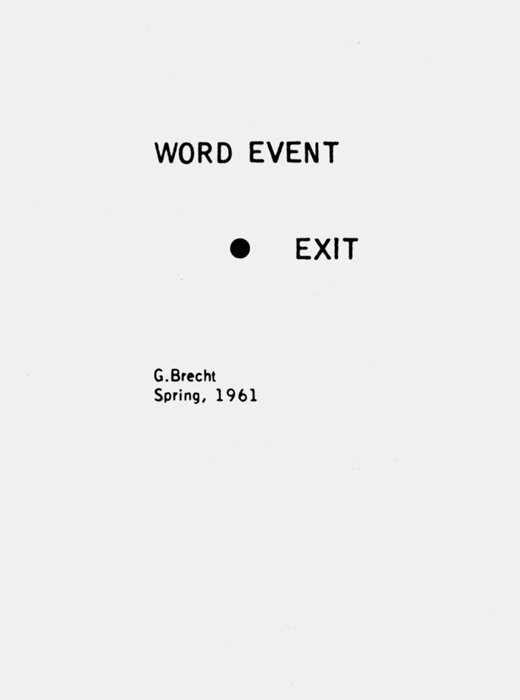
Word Event (George Brecht, 1961)
In their use of language as a device to cut into the evanescent everyday, [George] Brecht’s “insignificant and silly gestures” open an infinite universe of possibilities, just as [La Monte] Young’s precise operations move into the zones of the minimal and the series, of the same but inevitably different because virtually interminably—the line or the sound would go on in some sense “forever.” In both, the event is pared down to a minimum: a simple, basic structure that can be endlessly reenacted and reinscribed in new contexts, different in each instance and yet retaining a certain coherence. Inevitably calling to mind Lawrence Weiner’s highly condensed and yet generalizable “statements,” Brecht’s and Young’s most interesting scores reduce language to a kind of object, but also establish it as a kind of repeatable, replaceable structure, open to unlimited, unforeseeable realizations.
— Liz Kotz,
Posted by ben on December 6, 3:25 pm | Category: responses/reviews, video/film
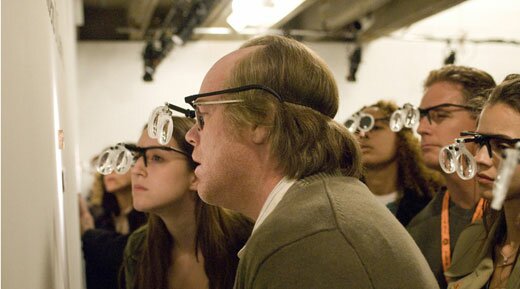
Many of the online discussions and reviews of Synecdoche, New York revolve around the perceived, and self-perceived, intelligence of the viewer. For those who like the movie, the critics who panned it are either too stupid to understand it, or too self-regarding to admit that it affected them. Others attack the admirers for feigning approval only demonstrate their own sophistication. These discussions reveal a lot about the problems with Charlie Kaufman’s latest navel-gazer.
First of all, let’s be clear about this: Synecdoche, New York is not a cinematic game-changer, as some have claimed. It’s fairly original, but is also very much a part of the meta-narrative tradition that stretches from Don Quixote to Inland Empire. “Woody Allen meets David Lynch” encapsulates the movie better than most X meets Y comparisons. Synecdoche doesn’t quite reach the wittiness of Woody Allen’s best work nor the ambitious narrative complexity of late David Lynch; but it’s kind of cool that someone tried to merge the clever, self-absorbed, hypochondriac artist with the non-linear, destabilized, semi-narrative form. What we end up with is a movie that is at turns poignant, funny, cliché and tedious.
Many reviewers agree that after about 45 minutes to an hour, the movie starts drifting and becomes tiresome. People said the same thing about Inland Empire, but Lynch does a better job of maintaining a sense of interpersonal tension, which combines with his consistently powerful cinematography to create enthralling scenes long after the overall narrative has shattered. The result is that as Lynch destabilizes the identities of his characters, they become more intriguing and perhaps more deeply human; as Kaufman does it, they become flatter and more cartoonish. There are some strong scenes late in Synecdoche, New York, but they are harder to come by as the characters are drained of emotional weight.
Charlie Kaufman invested a lot of energy in making this movie clever. Puns and double entendres abound, it’s a surrealism that makes fun of itself, but also takes itself seriously. It’s a fine line that at points Kaufman can’t quite toe, and the characters suffer for it. But the attempt is ambitious enough to make a certain segment of the movie-going public really want to believe that he did pull it off. It’s tempting for these people to assume that Synecdoche’s critics just don’t get it. On the other hand, it’s tempting for those same critics to accuse those who praise it of just being glad to be able to use the word synecdoche in casual conversation, and giggle at the high-minded puns. This cleverness is at once redeeming, as Kaufman is essentially making fun of himself, but also a roadblock to discussion, as people get hung up on the cleverness of the thing and forget to talk about its underlying meaning.
Posted by ben on November 27, 2:36 pm | Category: acquisitions, art paparazzi, design, public art, sneak peeks
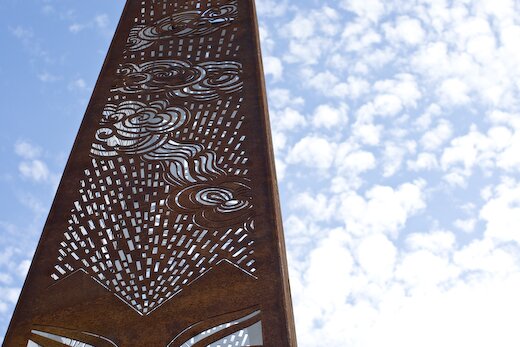
San Antonio’s newest public artwork was installed yesterday at the intersection of Blanco and Fulton, in the center of a new roundabout. The internal lighting system is not installed, however, and the piece will not be completed until a December 15 lighting ceremony. A press release sent out by Public Art San Antonio explains the significance of the piece:
The design of this new public art work at the roundabout draws a physical and spiritual link between “Beacon Hill”, the name of the neighborhood in which it is located, and its two most predominant architectural styles: Art Deco and Arts and Crafts. These are symbolically represented by the artwork’s two main components: a “sunburst” motif on the brick pavement of the roundabout and its obelisk-shaped “beacon/luminaria.” The “sunburst”, the most popular of all Art Deco motifs, metaphorically stands for its life giving force and the revitalization of the inner city business corridor. The “obelisk”, a symbolic quadrangular vertical sunray made out of steel, will serve as a sundial during the day. Its perforated allover design begins at the bottom with symbols of indigenous ancestral life cycles followed by references to the landscape that the traveler encounters on route to the town of Blanco, Texas.
Emvergeoning made it out to snap a few photos, followed by (highly recommended) pumpkin empanadas from the D.J. Bakery down the street.
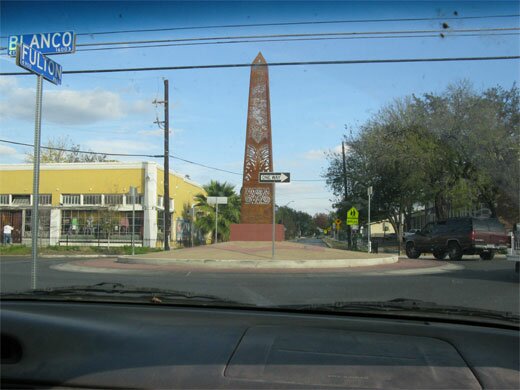

Posted by justin on November 26, 7:01 pm | Category: adventure day, architecture, art + bikes, art paparazzi, arts organizations
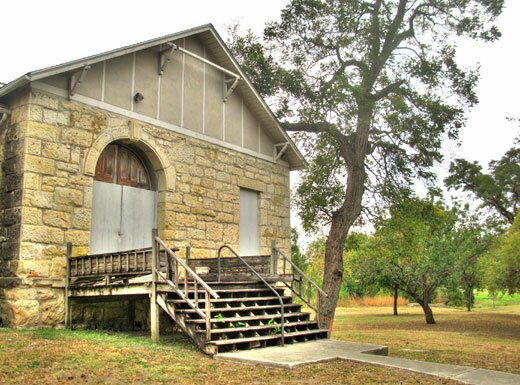
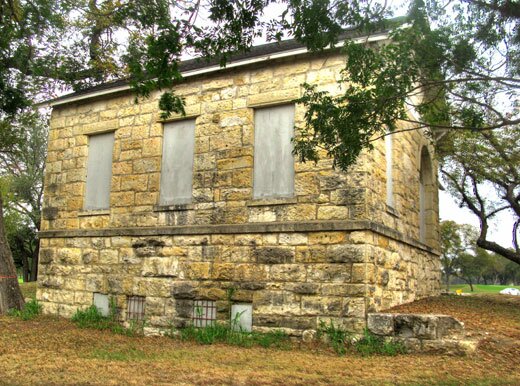
(Words by Gene Elder)
(Photos of Gutzon Borglum studio by Justin Parr)
(The following article is from CATCH-UP, a one issue art magazine that a group of San Antonio artists published in May of 1978.
I chose to write an article about Gutzon Borglum and his abandoned studio on the San Antonio River. It is an interesting history. Artists will find these facts important, as I did.
In 1978 we were protesting the lack of support for the arts. The abandoned studio of Gutzon Borglum where he created the model for Mt. Rushmore symbolized that lack of interest in the arts and the neglect of the creative community.)
IF ITS NOT THE ALAMO, then its just a studio
by Gene Elde_______________r
It has been my philosophy for some time now, that if you want to really enjoy an art exhibit, ignore the artist and the curator and go straight to the janitor. I have found that talking with the soul who picks up the trash after openings and daily sweeps the floors, empties ashtrays, polishes furniture and cleans the restrooms has the more interesting view of the arts. So with this in mind, I sat one Sunday on the steps of the Brackenridge Park Pumphouse and asked for wisdom from the Caretaker of the studio of Gutzon de la Mothe Borglum (The creator of Mount Rushmore.)
INNER VIEW:
There has not been a caretaker here in 10 years… people have forgotten this artistic heritage … but then perhaps that is the responsibility of a good studio, to remember the things that were created here and not to tell everything it knows.
But this studio told me that many times Gutzon sat here in ecstasy; thinking about the monument that would lift the hearts of America long after he had gone … (an artist learns that nothing is ever really his, only his to leave behind.)
Some of the time Gutzon sat here depressed and disenchanted from all the delays … but he understood that too. An artist is a servant as well as a leader and sometimes he must be both alone.
Many thought he was a little crazy … then again… most did not see the world the way Gutzon did.
This fateful studio, a two-story stone building near the Brackenridge golf course, was originally constructed under the supervision of George Washington Brackenridge in the mid-1880s. It served as the second pumphouse for the San Antonio Waterworks Co. until 1915 when it was abandoned. The pumphouse stood at the end of a long power canal which carried water to power turbines connected to a pump with a capacity of three million gallons daily. The water was lifted to the eastern end of Mahncke Park and in 1897 steam power was added to the station.
Gutzon moved to the abandoned pumphouse in 1924, using it as a studio for 13 years.
Now that the hor d’oeuvres have been served, to whet our appetite, shall we share a salad with our famous homemade house dressing?
While reading a book titled Unfinished Dream, by June Zeither and Lincoln Borglum, I enjoyed learning these things and have chronologically and alphabetically tossed them into the salad section.
Research revealed this famous South Dakota mountain site is named after a young New York attorney named Rushmore who was doing legal work for a mining company. When he asked the name of the peak, his companions answered lightly, “Hanged if we know! Lets call the damned thing Rushmore.”
Gutzon’s first model, completed in his winter studio in Brackenridge Park, was of three figures.
Washington: Since he represented the birth of the nation and the noble spirit which started a courageous people on an untried course.
Jefferson: To show the inspiration of the Declaration of Independence along with the foresight of the Louisiana purchase which expanded our country.
Lincoln: Representing the humanity, the suffering, the compassion, and the eternal unity of the nation.
When Roosevelt was chosen it brought forth a flood of controversy. Calvin Coolidge agreed with Gutzon that Roosevelt would properly round out this saga in stone. His enthusiasm for the American West, his efforts in behalf of labor along with the building of the Panama Canal, proclaimed Roosevelt to be the logical choice. To Gutzon this choice was right. “Regardless of what biased people may think of these four human beings, they were the ones who personified certain basic elements, crucial to our survival and growth as a nation.”
Not only was the choice of Roosevelt an issue, Gutzon’s angels commissioned by the Belmont Chapel of the Cathedral of St. John the Divine in New York City erupted into a nationwide controversy. The ecclesiastical hierarchy rejected the models on the grounds they appeared too feminine. “Angels,” they declared, “are masculine.”
Gutzon’s statue of Atlas bearing the weight of the world shocked the conservative. Delighting in this controversy, because “Atlas” turned out to be a woman, the sculptor explained that only woman has the strength and endurance for such a weight.
There was also a conflict with the Daughters of the Confederacy over Stone Mountain which ended with Gutzon destroying his clay models. They raised a furious cry and demanded the immediate arrest of the fleeing sculptor. Gutzon escaped into North Carolina with the law of Georgia hot on his heels. North Carolina’s Governor McLean announced he would call out the militia to protect the sculptor.
Besides being a sculptor, Gutzon served as a chairman of Central Park in New York and gave his thoughts to help San Antonio keep its historic Missions and meandering river. He also worked out an ambitious plan to beautify the entire state of Texas.
He gave a strong speech before the first National Arts Committee urging the government to promote a cultural consciousness in America. He felt that the government should scout out potential artist, but should never try to guide or mold the arts.
Gutzon’s plan for world peace was one of 20 selected for the Edward Bok American Peace Award for writers.
He regularly wrote “Letters to the Editor” delighting readers from coast to coast. They were well written, to the point, attention getting, and presented the unknown side of controversial issues.
Lincoln Borglum described his father as “a man of medium height, stocky build, and exceptionally broad shoulders. He had brown hair and piercing blue eyes. His cheeks were broad, his jaw square, and his chin determined. He was seldom seen without a brisk felt hat, which covered his balding head. His clothing was somewhat of a hybrid between that of an imaginative artist and a western bank president.”
Thrift, strict budgets, or bookkeeping were not necessary parts of Gutzon’s life. “Many times his commissions barely paid for the cost of his supplies, and often he would donate an important work, or turn part of his money back to the organization that commissioned him.”
Mount Rushmore took 16 years of his life. He died in debt, and his son, Lincoln, had to beg the government to pay Mary, Gutzon’s wife, the rest of the fees due Gutzon at his death.
Does
This
Ring
A
Bell
as we engage on an entree where it is
considered in bad taste to request
catsup ?
In 1937, Gutzon left his studio to the Witte Museum, where it was used for the Museum School of Art. This group eventually merged with the Art Institute, started by Marion Koogler McNay. Rumor revealed Etienne Ret, a French portrait painter invited here by Mrs. McNay to teach, worked in Gutzon’s studio. With these events a tradition was born. The tradition of handing down a studio. There were others who worked here before it closed in 1960; Max Fitzpatrick, Chester Tony, Jack Fletcher, and Dan Withers. Since then, various attempts have been made to utilize the building. Julie Black proposed a pottery studio in 1976, but the most recent renovation plan was prepared by Rudy Trevino. Today, after 18 years, we are slowly beginning to gather together at it’s cemented windows and locked door to re-call it’s role as contained in the words of Etienne Ret: “Perhaps I will not come back to teach, but I will come back, yes. San Antonio is after all one of the few cities where you can live life as it should be lived.”
Now there is a pleasant golf course with golfers walking and talking with the crew that maintains the lawns … joggers pass occasionally … people visit, even if only to ask questions about the pumphouse. But the community needs this place to be filled with artists again. It should be used as a meeting house by all the artists in San Antonio. Gutzon would like that.
Time has again brought us here to unlock The Studio doors. Not only the future, but now we know, the choice is to hear the knock or to ignore.
A Fortune Cookie,
begins our next course.
_____________________
CON SAFOS
_____________________
Posted by justin on November 22, 1:25 pm | Category: acquisitions, announcements
I’ve gotten this press release in several forms over the last few days. Enough that I put in an email asking for further information. If any of you are interested I’d suggest you do it as well. It could be a decent opportunity to have some work exhibited permanently in a public space.
CALL TO ARTISTS PRESS RELEASE
The Benham Companies and Arden and Associates are currently accepting proposals to provide visual art for the San Antonio Military Medical Center. Medical facilities that are part of this project are located at Fort Sam Houston and Lackland Air Force Base in San Antonio, Texas. These world class health facilities will house inpatient and outpatient ambulatory care as well as trauma and emergency medical care.
Artwork [proposed for these facilities] must reflect the principles of evidence based design and should capture the historical and artistic influences of the local community while promoting wellness and healing in the healthcare environment.
All artwork mediums will be considered for this project. Selected artwork will be displayed throughout the medical center buildings and at key locations on the sites.
Professional artists from San Antonio and surrounding areas are invited to become part of this exciting opportunity.
For more information, please email:
Cindy Bench
Posted by ben on November 18, 10:44 pm | Category: photography
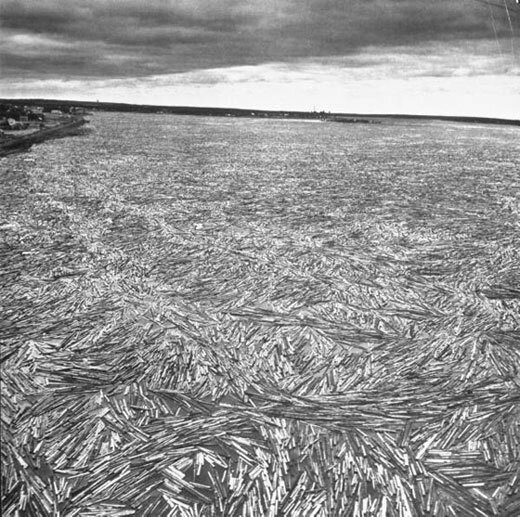
Logs jamming Kemi River during general strike (Photo by Mark Kauffman for LIFE Magazine, 1949)
A friend turned me on to the fact that Google is hosting over 10 million images from the . Enjoy.
[cross-posted at Scattered Work]
Posted by justin on November 11, 3:20 pm | Category: art paparazzi, party photos, performance art, possibilities, responses/reviews, vs.
Heres a short visual account of the opening affair at Artpace last Thursday night. Richie Budd’s pounding geriatric light show mixed with Taryn Simon’s noise-sensitive Cuttlefish made for an interesting experience..
(Lu Chunsheng’s work, also opened that night, is not pictured).
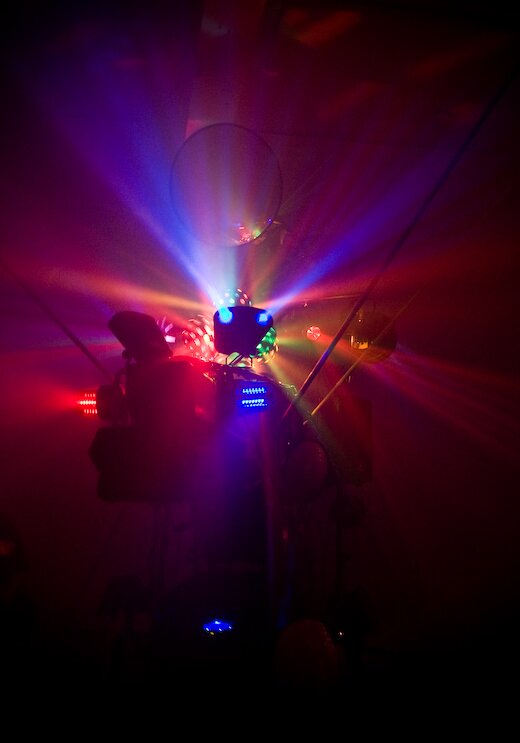
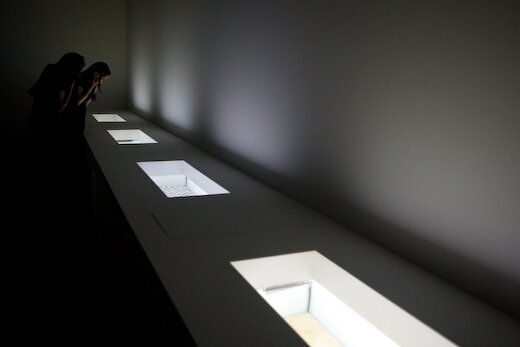
(follow the link for more photos and video of Richie Budd sculpture in action)
Posted by ben on November 10, 2:39 pm | Category: arts organizations, politics, silliness
George W. Bush: “Lame duck, huh? I’ll show you what a lame duck can do!”